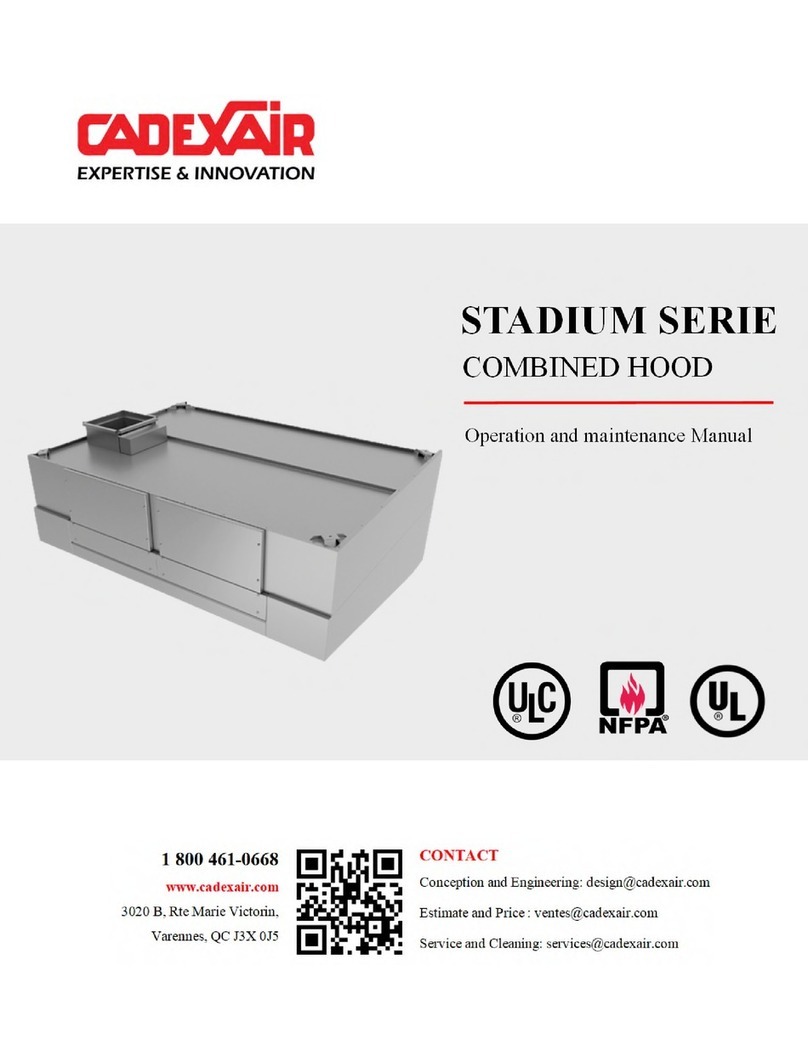Doc150313-01
Installation and maintenance manual
www.cadexair.com 9 1010, Boulevard Lionel Boulet
1-800-461-0668 Varennes, Québec, Canada J3X 1P7
To get rid of water stains, rinse with clear hot water.
You can also avoid water stains by wiping the surface
with a soft and dry cloth. A non-abrasive cream
product or a cleaning product can be used for light
superficial stains. Products specifically designed for
stainless steel cleaning and containing citric acid can
be used. Nylons scouring pads are recommended to
remove the majority of food premises. If a more severe
treatment is required to get rid of stripes and surface
scratches, it is recommended to use a very thin
abrasive to avoid damaging the surface. If stainless
steel has a direction or a special pattern, repairs must
be aligned with the direction of the original finish to
obtain a more esthetic result. If a metallic brush is
used, it should be made of stainless steel from the
same steel gauge then the exhaust hood material. It
is important to verify that the abrasive used are exempt
of all contamination like chloride and iron. If you need
to clean the surface with a chemical product or an
abrasive, we recommend making a test first on a non-
showing surface to verify the results.
If the above advice does not provide a satisfying result,
remember that stainless steel can be polished on site
by specialists, manually or mechanically. Stainless
steel is solid and not plated; therefore, it doesn’t lose
its corrosion resistance properties following a
polishing.
Daily maintenance
•Wipe the visible inner and outer parts of the
exhaust hood.
•Verify the control panel display to ensure good
functioning of the system.
•Wipe the visible parts of the Geo-Vary grease
extractor.
Weekly maintenance
•Remove baffle filters and clean or soak with a hot
water and degreaser solution.
•Empty all grease cups located under modular
extraction baffles.
Monthly maintenance
•Remove and clean all filters.
•Clean the grease gutter.
•Verify the exhaust fan motor belt.
•Verity the filters from you air supply system.
Geo-Vary grease extractor maintenance
When necessary:
•Remove the Geo-Vary grease extractor from the
exhaust hood filter cage. Remove the guillotine
from the extractor by removing the wing nut
located inside the extractor, in the back.
•Put the guillotine and extractor upside down in a
dishwasher or simply wipe the inside surfaces
with detergent and hot water.
•Put back the guillotine in the extractor according
to hit initial setting and screw back the wing nut.
•Install the Geo-Vary grease extractor according to
indications of Annex 3.
Inspection and cleaning of the commercial kitchen
exhaust system
Inspection of the commercial kitchen exhaust system
is mandatory.
Owner of commercial kitchen are obligated to regularly
have their exhaust system inspected in order to ensure
the security of their employees and the public in
general. The system includes: exhaust hoods,
filtration units, exhaust ducts and exhaust fans.
Make an inquiry to your insurance provider about the
required inspection by local standards for your type of
establishment. Refer to annex 4 for more information
about the required inspection schedule according to
the NPFA96 standards.





























